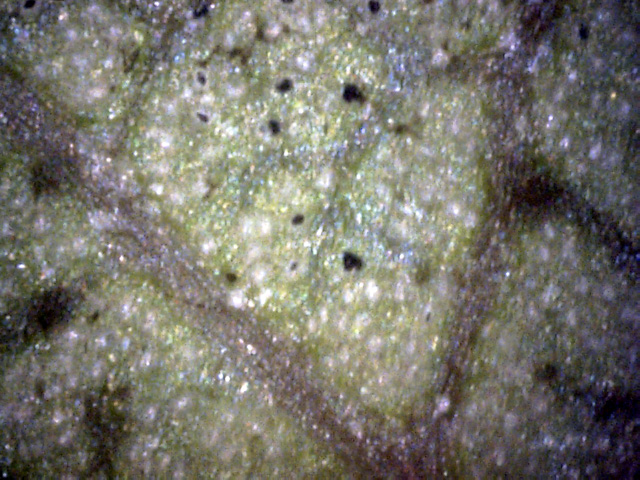While there are a variety of flowering trees in our neighborhood, in my opinion the
most beautiful one is a flowering peach on a nearby street. Every year it's a joy to
look at when in full bloom. But the tree seems to be in decline. The peaches it
produces are small and stunted. Pictures 1 and 2 below show this tree. Picture 3
shows another peach tree.
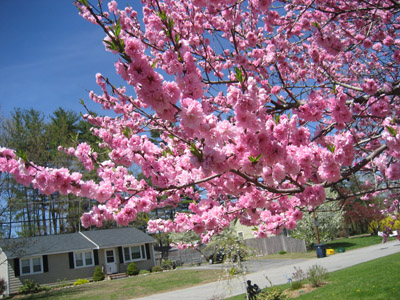
1
In spring, this is probably the prettiest flowering tree in our neighborhood. It's a peach tree,
although the peaches that develop are small and hard. You might not guess that this tree is
in a state of decline by looking at it. This photo was taken in early May, 2007.
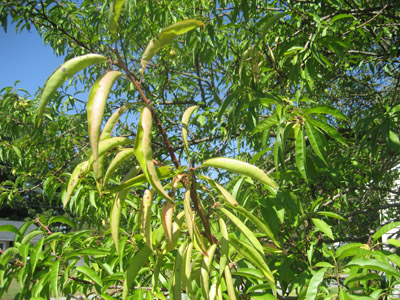
2
Three months later, in late August, this is what one branch looked like.
The diseased leaves here are curled and have lost their rich green color.
In their weakened state, they have also been more susceptible to insect attack.
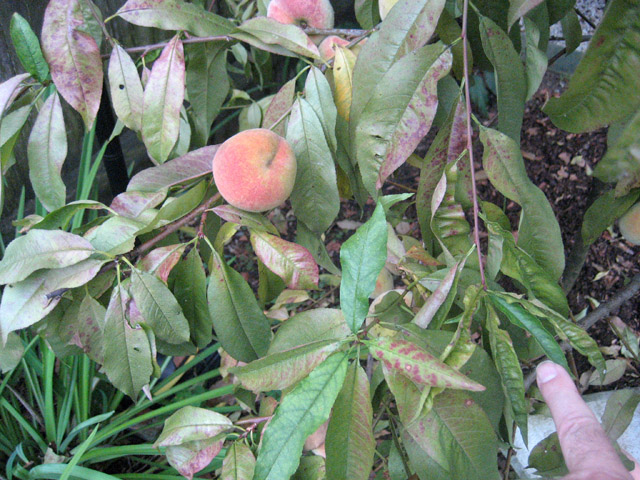
3
This is another, smaller peach tree in my neighbor's yard.
It, too, is suffereing from disease.
Notice that the leaves are generally dull in appearance, wavy on the edges,
sometimes wrinkled in the middle, and toward the end of the growing season
show some red color between the veins.
You can't see it here, but this tree had already begun to drop dead leaves.
This picture was taken Sep 1, 2006.
Curious as to why the peach tree shown in pictures 1 and 2 was in decline, I snipped off a branch for analysis.
The sample was taken in mid-October. The pictures below were all taken with a 400x digital microscope.
We begin with pictures of leaf tops.
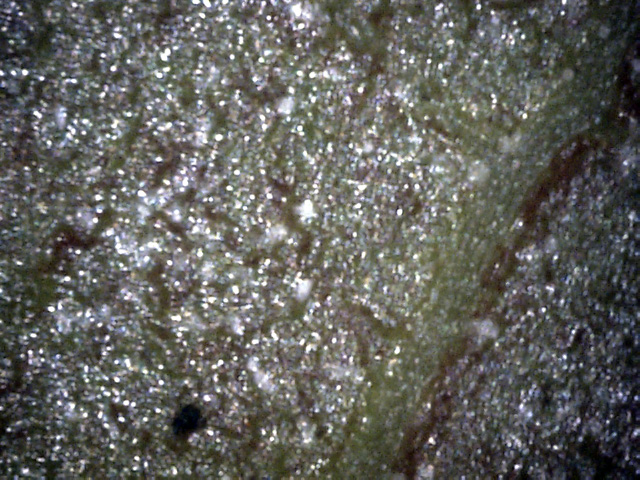
4
The faint white spots hint at the particles of white canker present within the leaf.
But there appears to be no white canker material on the leaf surface itself.
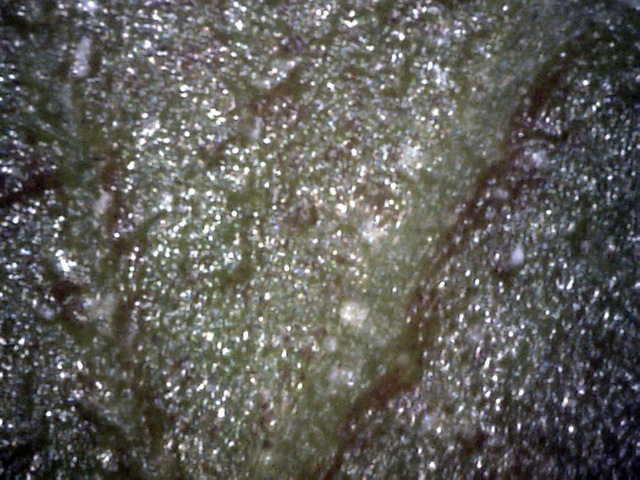
5
The white spots hint at the particles of white canker present within the leaf.
These spots don't seem to break the leaf surface, and they seem to cluster near the leaf veins.
White canker often shows a preference for leaf bottoms, which are shown in the following set of pictures,
again at a 400x magnification.
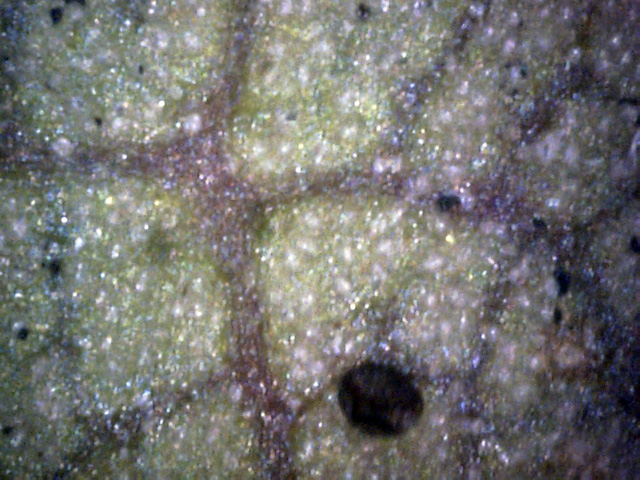
7
More white spots hinting that there are white canker particles within the leaf.
There seem to be more of them on the right side, which appears a bit less healthy.
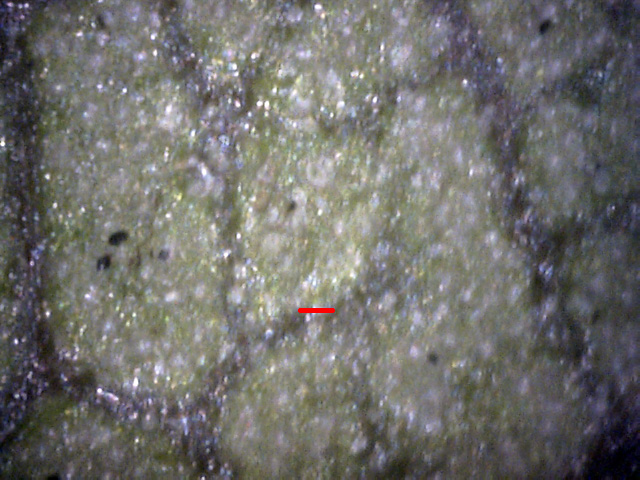
8
Look carefully at these white spots, and you will see that they have the general appearance
of white canker spores. The red bar is 50 micrometers long, about the diameter of a white canker spore.
Fortunately we have a means to lift the veil and take a peek inside the leaf: mount the leaf in a vise,
slice it along the vise top, and examine this top with a 400x microscope.
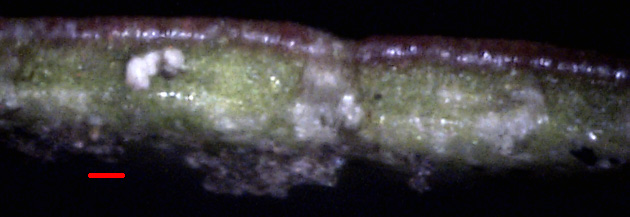
9
There is a solid vertical band of canker running through the leaf here, and on the left there are
some buried canker spores that were exposed by the cut.
The red bar is 50 micrometers long, indicating that the spores are about 30 micrometers in diameter.
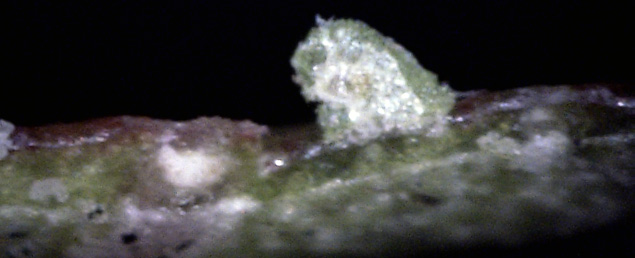
10
By good fortune, the razor partially tore off a small piece of leaf surface and bent it up, showing
us that there is indeed a thin layer of extensive canker growth just under the leaftop surface.
The cross-sections hint that there is a thin band of canker, but this picture actually shows it.
Notice that the bottom leaf surface also shows some canker patches.
Perhaps bottom surface views don't show it due to its thinness and transparency.
Only edge views like this bring it out.

11
There is a band of canker running from the top of the leaf to its bottom in the center of the picture.
More important, though, is that this picture shows that the canker generally forms a thin layer
just below the top surface of the leaf, and also a slightly more diffuse layer just above the
bottom surface of the leaf.
Together they show why, while white canker is extensively present, viewing the top or bottom of a
leaf may not show much of it.
In general, the best means to determine the presence of white canker is by examining the cross-section of a twig
at 400x, as is done in the following set of pictures.
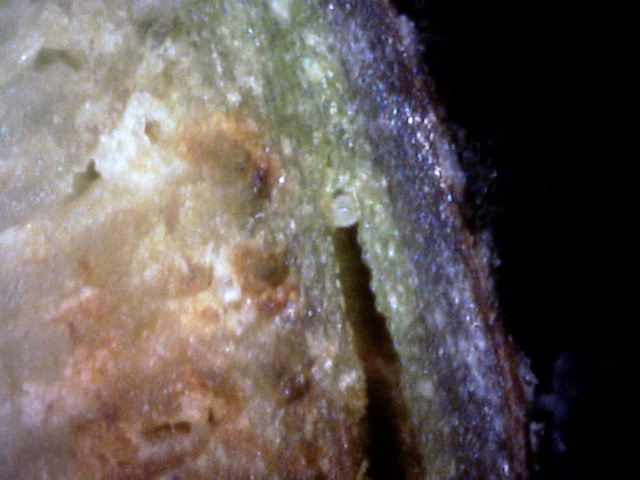
12
White canker is killing this area.
Note that the split in the green cortex begins at a particle of white canker.
A blob of white canker is growing just to the left of it, blocking a vessel.
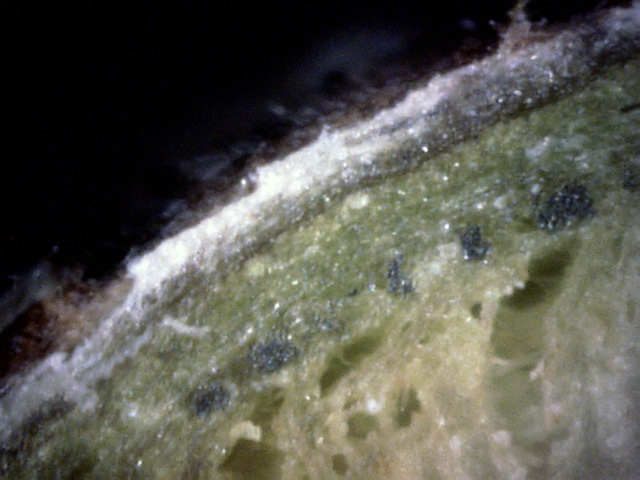
13
This picture shows a heavy white canker infection just below the surface of the bark.
But the green phloem so far doesn't seem to be infected badly.
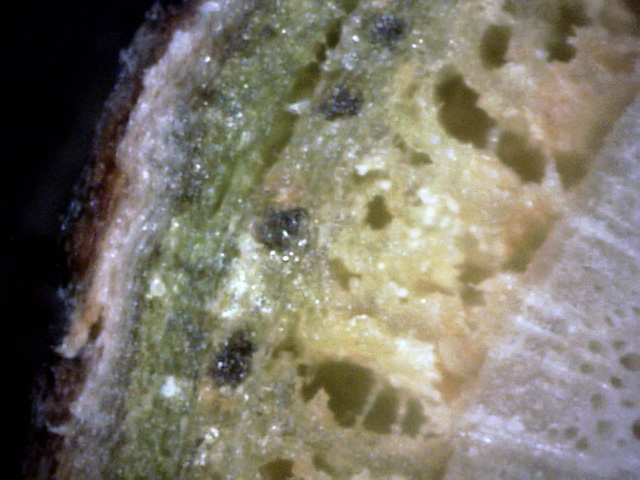
14
The extensive growth of white canker just under the outer bark is consuming it and killing the outer
surface, turning it black.
The green cortex under it is starting to get attacked and is developing some voids.
Under that is the nutrient transporting phloem layer.
Its spongy yellow appearance seems to indicate it is dying.
The only thing in good shape is the snow-white xylem in the lower-right part of the picture.
So the tree can still transport water and minerals up from the roots, but nutrients generated
by the leaves are having a hard time getting around.
That would explain why the peaches produced were stunted in their growth.
Now that we've seen inside the bark, let's look on the outside. The first view, like the others above,
is at 400x. Typically, top-of-the branch bark views such as this show little of interest.
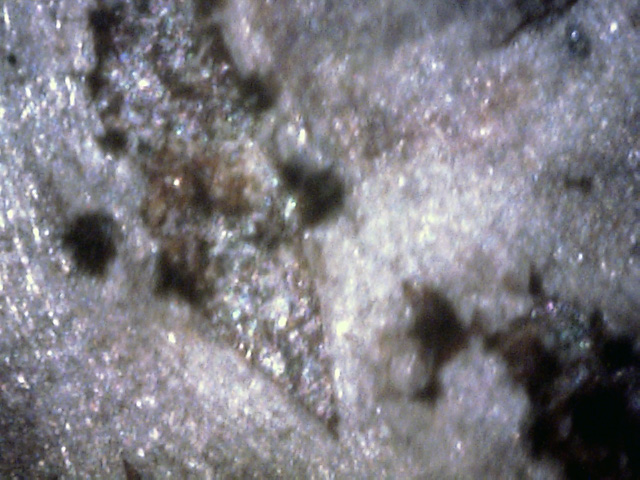
15
Note the lack of spores on the upper surface of the twig.
But it does appear that there is a thin layer of canker there that has split, possibly due to
underlying canker growth.
In contrast, if a tree is infected with white canker, the bottom of the branch junction near the branch tip is
often a hotbed of spores. Unfortunately, these spores are barely visible to the naked eye. This junction was located
12 inches from the branch tip. These are 400x views of the junction bottom.
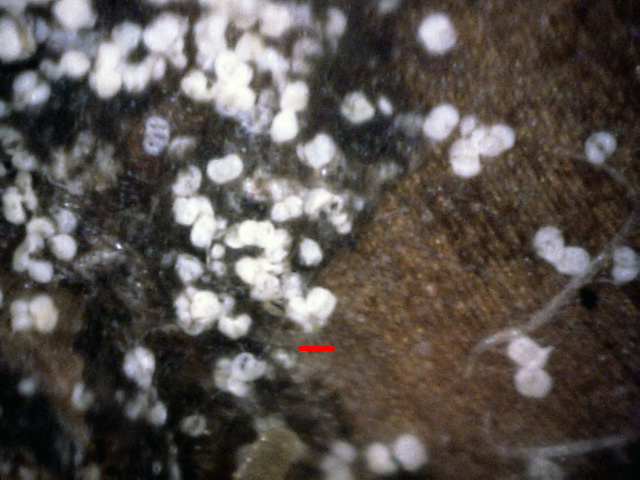
16
This is a view of the bark on the bottom of a twig, about 1 foot from the twig tip.
This is the usual spot where spores form.
Note that there isn't a single yellow embryonic spore present here, indicating
that these are old spores.
This wood was created two years ago.
The red scale bar is 50 microns long, so these spores are about 40 by 50 microns in size - identical
to those on other trees affected by white canker.
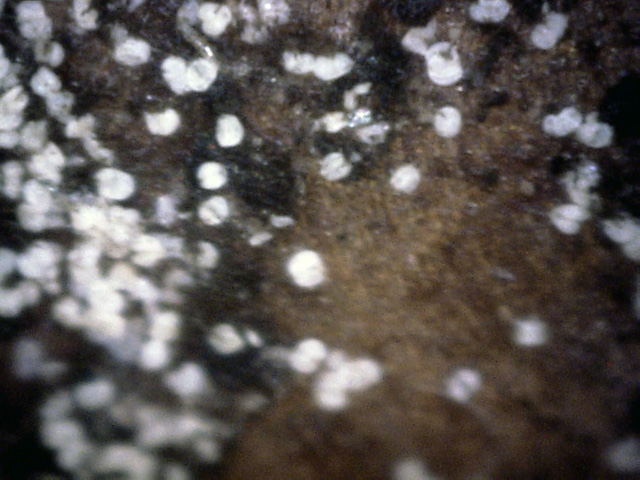
17
Another view of spores on the bottom of a twig node (branch junction), where they seem to gather.
To the eye, these spots appear as a barely visible gray patch, almost like fine dust or dirt.
It's sooo easy to pass them off as that!
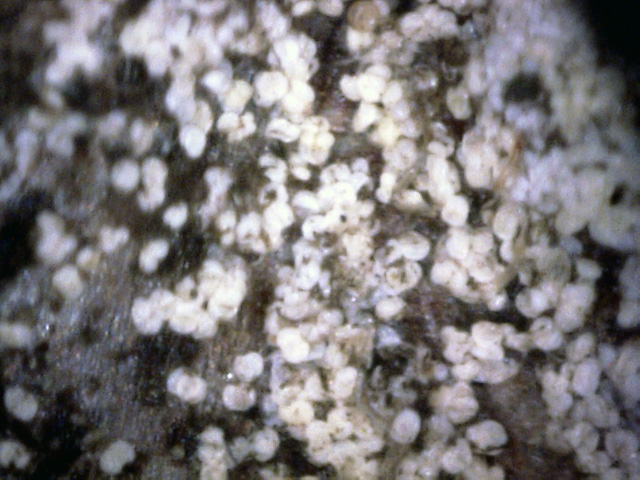
18
One of the densest patches of white canker spores I found at the twig bottom node.
Of particular interest here is the gray-brown stuff oozing from the "mouth" of many of the spores.
For some reason these spores did not release, and are sending out hyphae to infect itself!
(The roundness of the twig makes it difficult to focus on all parts of the field of view here due to
limits on the depth of focus of the microscope.)
In summary, this beautiful flowering peach is moderately infected with white canker.
Except for general tree decline and mild bark fissures, all the strong evidence for
white canker comes from the 400x microscopic views described next.
Although the leaf bottoms and tops show only faint white particles, a leaf cross-section view shows internal
canker growth, mainly in thin sheets near the leaf surface. As usual, stronger evidence comes from the
examination of twig cross-sections. There we see strong white canker growth consuming the inside of the outer
bark. The phloem is also taking a beating. Further strong evidence comes from the bark surface,
at branch junctions. As in other infected trees, there are no white canker spores on the top (upside) of
the branch, while there are abundant spore patches on the bottom (downside) of the branch. Their pure white
color seems to indicate they have been there for some time (they lack the young embryonic yellow tinge).
